by W. Cranshaw* (1/20)
Quick Facts…
- Brown soft scale is common insect pest of many indoor plants, including Ficus, Schefflera, English ivy, and citrus.
- When brown soft scales feed they produce a shiny, sticky fluid called honeydew that may cover leaves.
- Insecticidal soaps or horticultural oils can control brown soft scale, but these will require multiple treatments to be effective.
- A systemic insecticide (imidacloprid) that is applied to the soil provides good control of brown soft scale on ornamental plants.
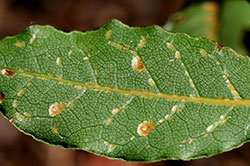 Figure 1: Brown soft scale, in mixed stages, on the underside of a leaf. |
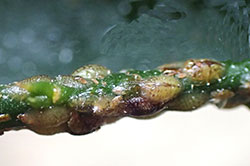 Figure 2: Brown soft scale on a stem of citrus. Most are adults and they have a shiny covering of honeydew. |
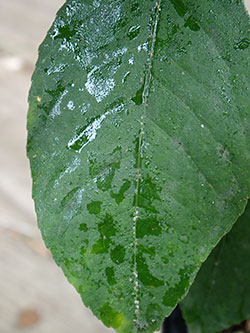 Figure 3: Honeydew, excreted by brown soft scale, which has collected on a nearby leaf. |
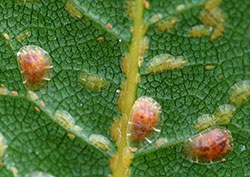 Figure 4: Soft brown scale in mixed stages. Larger, darker scales are adults. A tiny first stage nymph (crawler) may be seen in the upper, center-left. |
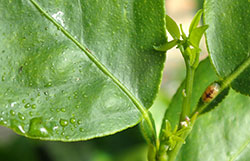 Figure 5: An adult brown soft scale is present on the petiole of a citrus leaf in the right of the photo. The honeydew excreted by the insect is on the leaf in the lower left, a few inches away. |
Brown soft scale (Coccus hesperidum) is the most important scale insect that occurs on indoor grown plants in Colorado. When feeding it excretes a large amount of sticky honeydew that can cover leaves and create serious nuisance problems. Heavy infestations can cause leaves to prematurely shed, and branches to die back.
Brown soft scale occurs worldwide and has an enormous range of recorded host plants, including 125 families of plants in 363 genera. Brown soft scale is only known to occur on indoor-grown plants in Colorado, but occurs year-round on many kinds of landscape plants in areas within the United States that have milder winters. Indoor-grown plants most commonly infested in Colorado include citrus, Schefflera, Ficus, English ivy, and bay leaf.
Description and Habits
Brown soft scale is found on both stems and leaves. When full-grown it is about 4-5mm long (ca. 1/8-in) and normally has an oval body form, although shape can vary depending on the site of the plant where it develops. The body is quite flat, appearing only slightly domed when viewed from the side. Color ranges from yellow-green to yellow-brown and scales may be mottled with some brown spots. Older scales usually become darker brown.
Only females are produced. When mature, the mother scale produces eggs that hatch within her body, producing very tiny (0.4mm) first stage scales known as crawlers. Crawlers may live for a few days under the protective cover of the mother scale, but later move to colonize other areas of the plant. Stems of plants are usually favored sites where brown soft scales will settle, but they also can occur on leaves. The crawler period is the most mobile stage of the insect and is the stage that would infest new plants. Crawlers can be moved and carried while handling infested plants and may be able to be blown short distances.
After the crawler has settled it begins to feed with its piercing-sucking mouthparts. These are used to reach the sugar-rich fluids present in the phloem vessels of the plant. As they feed, the scale insects excrete excess water and sugars, producing honeydew, a sticky, shiny fluid.
Within a week or two after birth, the scale will molt to a second stage, which is still quite small, only about 1.0 mm in length. During this period the scale will normally remain in place, but can still move. The second stage of brown soft scale may last for about 6-8 weeks followed by a final molt to the adult form.
The adult form grows considerably as it produces and matures eggs, doubling in size within a couple of weeks. Once females begin to reproduce they do so continuously, so that a few crawlers will be produced daily over 3-4 weeks or more, after which the female dies. On indoor plants multiple generations will be produced each year. Because the scales are laying eggs over an extended period, generations overlap and there will be no distinct annual peaks in egg production and new crawlers.
Management of Brown Soft Scale
Monitoring. Early detection can greatly improve the ease of managing brown soft scale. The insects can be difficult to detect since they are small and may blend in well with the plant. However, the honeydew they produce while feeding provides an excellent means to easily detect the presence of this insect.
The honeydew produced by brown soft scale may pool next to the insect. Often, the honeydew is ejected, sometimes over an inch or more away from the body, and ultimately lands on a leaf below or aside the insect. By regularly checking plants every couple of weeks, early infestations can be recognized by the presence of the honeydew this insect produces.
Monitoring for honeydew can also be useful to determine if insecticides have been effective. Since the scale insects will often remain attached to the plant after death, the detection of honeydew can be evidence that the insect is alive and continuing to feed.
(Note: There are other insects occurring on houseplants that also produce honeydew. Aphids are perhaps most common. Mealybugs and other kinds of soft scales, such as hemispherical scale (Saissetia coffeae) and nigra scale (Parasaissetia nigra), also excrete honeydew.)
Biological Control. In outdoor settings there are often numerous natural enemies that attack and greatly limit brown soft scale. Most important are several types of small parasitoid wasps that develop within the body of the scale, ultimately emerging through a hole they cut in the back of the body.
Presently there are no reliably effective natural enemies available to control brown soft scale indoors. Generalist predators such as larvae of green lacewings and the predatory beetle Rhyzobious lophanthae will feed on brown soft scale and may help reduce numbers of the scale in some situations. However, if large amount of scales are present and large amounts of honeydew are covering the plant these natural enemies will not be effective.
If it is practical to move plants outdoors then some biological control can occur by some of the generalist natural enemies that are normal residents in yards – lady beetles, green lacewings, various predatory flies and other beneficial insects. Moving plants outdoors also allows plants to be easily sprayed and washed so that they honeydew can be removed.
Insecticide Options (Indoors). There are several insecticides that can be used to control brown soft scale (Table 1).
Insecticidal soaps (potassium salts of fatty acids) can be used as dilute sprays. Insecticidal soaps will only kill insects that can be covered during application but are usually very effective against the first stage crawlers. Since insecticidal soaps can only kill insects contacted during application, treatments will need to be reapplied to kill insects that were not exposed during application, including later hatched crawlers. Insecticidal soaps can be used on edible plants (e.g., citrus, herbs).
Several kinds of horticultural oils are available to be used to control insects and mites on plants. These are designed to be mixed with water (1-2% concentration) and sprayed on the body of the insect. Horticultural oils primarily kill the insect by smothering, blocking the small openings through which it breathes. Commonly available horticultural oils are either mineral oils or neem seed oils.
Horticultural oils will only kill insects that can be covered during application. Stages of the scale will remain that cannot be killed in a single spray, such as crawlers that remained protected under the cover of the mother scale or newly laid hatched eggs. To be effective for control of brown soft scale, oil sprays will need to be repeated several times. Horticultural oil products can be used on edible plants (e.g., citrus grown for fruit, herbs).
Soil-applied systemic insecticides can be used on some plants. The insecticide imidacloprid can move systemically within plants and may provide excellent control of brown soft scale. Houseplant products containing imidacloprid are applied to the soil as granules or a drench, then watered into the soil so that it can be picked up by roots.
At present (January 2019) there are two imidacloprid products labeled for indoor use on houseplants: Bonide Systemic Houseplant Insect Control (2.2% imidacloprid) and Bayer Advanced 2in1 Insect Control Plus Fertilizer (2.5% imidacloprid). Neither of these products allow use on indoor grown food crops – such as citrus being grown for fruit and herbs. Horticultural oils and insecticidal soaps remain the only options for control of brown soft scale when food crop plants are grown indoors.
Insecticide Options for Outdoor Grown Plants. If plants are moved outdoors during the warmer months, and are then grown as an outdoor ornamental plant, a few other insecticide options exist. These primarily include sprays of various pyrethroid insecticides, such as cypermethrin, cyfluthrin, lambda-cyhalothrin, and permethrin. These have ability to persist on the plant for several days, providing better ability to kill the young crawler stages of the scale. However, pyrethroid insecticides usually cannot control older scales that have developed a protective waxy cover. Alternately, sprays of certain systemic insecticides, containing imidacloprid or acetamiprid as the active ingredient, can also be used on outdoor grown plants, and these can also provide good control of all stages of brown soft scale. Label instructions for most of these products limit their use to ornamental plants and they cannot be used on plants with fruit or foliage that is edible.
Table 1. Some insecticides that may be useful to help manage brown soft scale on houseplants when grown indoors and when grown outdoors.
| Active ingredient | Examples of Trade Names1 |
|
Allowed for use on indoor grown plants |
|
| Insecticidal soap | Bayer Advanced Natria Insecticidal Soap, Bonide Insecticidal Soap. Earth-tone Insecticidal Soap, Garden Safe Insecticidal Soap, Safer Insect Killing Soap |
| Horticultural oils (mineral, neem) | Bonide all seasons horticultural & dormant spray oil, Bonide Neem Oil Concentrate, ferti-lome Horticultural Oil Spray Concentrate Garden Safe Neem Oil Extract, ferti-lome Triple Action (plus pyrethrins), Safer EndAll Insect Killer (plus pyrethrins and insecticidal soap) |
| Imidacloprid | Bonide Systemic Houseplant Insect Control, Bayer Advanced 2in1 Insect Control Plus Fertilizer |
|
Only allowed for use on plants when grown outdoors |
|
| Acetamiprid | Ortho Rose and Flower Insect Killer |
| Imidacloprid (plus cyfluthrin) | Bayer Advanced Dual Action Rose & Flower Insect Killer |
| Cyfluthrin | Bayer Advanced Rose & Flower Insect Killer |
| Cypermethrin | Garden Tech Sevin Concentrate Bug Killer |
| Lambda-cyhalothrin | Spectracide Insect Killer for Lawns and Landscapes |
| Permethrin | Bonide Eight Insect Control Vegetable, Fruit & Flower Concentrate |
1 Partial list of trade names, based on products found displayed on retail shelves in Colorado during a 2018 survey. Other unlisted products may exist that can also be used. Always check the label instructions when using any pesticide. All pesticides can only be used in a manner that is consistent with the use directions of the pesticide label.
The original version of this publication was produced by R.E. Stevens of the Rocky Mountain Forest and Range Experiment Station, D.A. Leatherman, entomologist with Colorado State Forest Service and J.W. Brewer with the former Department of Zoology and Entomology of Colorado State University. Revised by W. Cranshaw, entomologist, Extension, Colorado State University. 3/95. 1/20.
Go to top of this page.





